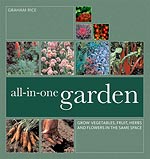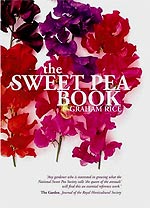
Fast Forward - Perennials that can flower in their first year
November 2001
There is no doubt that raising hardy perennials from seed is tempting. When you can buy a whole packet of seeds for the price of a single plant the attraction is obvious; the problem, of course, is that when you start with seed it takes time for the germination and development of the seedlings through to flowering. When you buy a plant it might well already be in flower, or will flower soon after it arrives in the post.
In recent years plant breeders and seed companies have addressed this issue. In particular, breeders have developed cultivars intended to be grown from seed and which will flower later the same year after a spring sowing; these are now more common and are often marked as such in mail order catalogues.
They have the advantage of being economical, bringing colour to borders in their first summer - and then continuing to flower year after year.
Are they as good?
The question, of course, is this: are the seed-raised perennials which flower in their first year as good as other perennials? The answer is: Sometimes. Three recent trials at Wisley, when traditional vegetatively propagated cultivars were grown alongside those raised from seed, illustrate the full range of possibilities.
The recent trial of perennial lobelias was absolutely conclusive in proving that seed-raised lobelias not only flower prolificially in their first summer but dramatically outclass the vegetatively propagated cultivars.
Some years earlier, the trial of delphiniums from seed proved that most seed-raised cultivars will flower well just a few months after sowing and a number of AGMs were awarded. However, although the overall impact of the stands of plants was certainly impressive, the quality of the flower spikes did not match that of the vegetatively propagated cultivars growing nearby. And, unfortunately, the cultivars to which AGMs were awarded are now largely unavailable.
In a disappointing example, when seed-raised monardas were grown alongside those propagated from cuttings the vegetatively propagated forms proved far superior.
It is worth saying, of course, that perennials raised from seed which take two years or more to flower, like paeonies, hellebores, euphorbias and many more, may well produce superb plants - but they do take their time.
Unfortunately it is not possible to be sweeping in recommendations as to genera which will flower in the first year; it would be simpler and more helpul to say that achilleas or lychnis can be treated in this way - if it were true. It is, however, necessary to be selective and only recommend certain cultivars.
Another unfortunate problem with a number of the better first-year flowering perennials from seed is that they are only available in mixtures; so a range of colours will be produced but this is not always what you need when planning a border display. Achillea ĺ─˛Summer Pastelsĺ─˘, ĺ─˛Floristanĺ─˘ carnations, Kniphofia ĺ─˛Flamencoĺ─˘, Prunella ĺ─˛Pagodaĺ─˘ and Veronica ĺ─˛Sightseeingĺ─˘ are good examples.
Used thoughtfully in the garden, some mixtures can work well. As an island of sparkling colour surrounded by the neutral green of spring flowering shrubs and foliage perennials, Kniphofia ĺ─˛Flamencoĺ─˘ and especially Prunella ĺ─˛Pagodaĺ─˘ can make quite an impact.
But it is perhaps more wise to wait before planting out seed-raised mixtures in their final homes in the garden. Simply plant them in a row, or in a group in a temporary site, select the individual plants which especially appeal and then move these to carefully considered sites.
It is also worth remembering, however, that mixtures can vary. Always prick out the weak and the strong seedlings, also the pale and the dark green, to be sure of a full range of shades and be aware that the seed companies may vary the balance of colours from year to year.
A choice of first-year flowering perennials
Achillea ĺ─˛Summer Pastelsĺ─˘ is a wide ranging blend, which includes deeper, richer shades as well as pastel tones. Selected for its early flowering, the height may vary and I found an occasional attractively dwarf plant amongst my seedlings. They will flower long and prolifically in their first summer, but be aware that the plants can be invasive and that self-sown seedlings may soon be all too evident.
Agastache With their powerfully fragrant foliage, and their appeal to bees, agastaches have attractive features in addition to their dense spikes of flowers. ĺ─˛Fragrant Delightĺ─˘ mixes flower colours (blue, cream, red, pink and white) with aroma (mint, liquorice and aniseed). The height can vary from 18in/45cm to 3ft/90cm which makes a mixed group unsatisfactory. ĺ─˛Apricot Spriteĺ─˘ is dependably shorter at about 15-18in/38-45cm with burnt orange flowers but may not survive cold winters in poorly drained soils.
Coreopsis ĺ─˛Early Sunriseĺ─˘ is one of the most prolific of first-year flowering perennials, smothered in yolky yellow double flowers, on slender stems above a dense mound of fresh green foliage. The smaller flowered pink C. rosea ĺ─˛American Dreamĺ─˘ is daintily attractive but invasive.
Dianthus ĺ─˛Crimsoniaĺ─˘, sometimes listed as ĺ─˛Red Featherĺ─˘, is a superb semi-trailing deep red single dianthus with fringed petals. Great in borders with dark coleus, purple-leaved beetroot or interweaving ĺ─˛Lime Greenĺ─˘ nicotiana in its first year and with a sunproof yellow hostas like ĺ─˛Zoundsĺ─˘ in succeeding years. Look out too for the hard to find ĺ─˛White Featherĺ─˘.
Carnations from seed are invaluable if you appreciate a long succession of cut flowers in a full mixture. ĺ─˛Championĺ─˘ combines the widest range of self colours in rich and pastel chades plus picotees - and when I grew them, every one was scented.
Leucanthemum In their first summer, the huge white daisies of ĺ─˛Snow Ladyĺ─˘ are a little out of proportion as the plant only reaches 9-12in/23-30cm high. But thereĺ─˘s no doubt about the impact and in succeeding years, when the plant grows a little taller, the look is altogether better balanced.
|
Linaria ĺ─˛Canon Wentĺ─˘ is a fine perennial with slender spikes of rose pink flowers, lovely with silver artemisias. It is also available in a blend with the purple-flowered species as ĺ─˛Bishops and Canonsĺ─˘. Seed of the shorter white ĺ─˛Springside Whiteĺ─˘ is occasionally available and this looks pretty alongside Hosta ĺ─˛Halcyonĺ─˘.
Lobelia I have long given up growing the old (and the new) vegetatively propagated lobelias as the seed-raised ones are so spectacular. They come in two series: Kompliment is the taller, at about 3ft/90cm, and relatively unbranched while Fan is the smaller flowered, bushier and shorter one reaching about 2ft/60cm. Both are relatively expensive and have the tiny seed familiar from bedding lobelias.
Kompliment Scarlet was awarded an AGM after trial, when I grew it four spikes were produced on one plant in the first summer and ten in the second. Four of the Fan Series were awarded AGMs, Fan Deep Red has bronzed foliage. Unfortunately it may be hard to find anything but mixtures.
Penstemon True, penstemons will flower in their first summer from spring cuttings - if the parent plants have overwintered. The prolific ĺ─˛Tubular Bells Roseĺ─˘, in pale rose with a prettily red-speckled throat, and ĺ─˛Tubuar Bells Redĺ─˘ should make four stems per plant in their first summer from seed and then have as much chance of making it through the winter as other large-leaved cultivars.
Prunella A sparkling rolling carpet of Prunella ĺ─˛Pagodaĺ─˘, almost deafening with bees in the summer sunshine, is quite a feature. In purples, pinks and white - with some bicolours - this is low, vigorous, easy and long-flowering.
Veronica The oddly named ĺ─˛Sightseeingĺ─˘ is a three colour mixture (blue, pink and white) intended for cutting but as useful in the border. Set in front of perennials with a horizontal accent, achilleas perhaps, it flowers for many weeks.
Also tryĺ─Â
Delphinium ĺ─˛Centurion Whiteĺ─˘ and ĺ─˛Centurion Blueĺ─˘ are the best of the current traditional delphiniums from seed, though the ĺ─˛New Millennium Hybridsĺ─˘ and ĺ─˛New Zealand Hybridsĺ─˘ also look promising; the dwarf 'Magic Fountains' often disappoints. D. cardinale, ĺ─˛Butterfly Hybidsĺ─˘, D. nudicaule and ĺ─˛Laurinĺ─˘ with their more dainty flowers in various red, orange and yellow shades all flower in their first year but may not last the winter.
Hollyhocks often also flower in their first year, especially ĺ─˛Summer Carnivalĺ─˘ and dwarf cultivars like the hard-to-find ĺ─˛Majoretteĺ─˘ although the dwarf types in particular rarely last the winter.
Lychnis can be good in their first year, especially L. haageana ĺ─˛New Hybridsĺ─˘ and ĺ─˛Vesuviusĺ─˘, though they need good drainage to be sure of lasting the winter as does the delightful Mexican hat, Ratibida ĺ─˛Red Midgetĺ─˘.
Raising perennials for first year flowering
An early start is vital and the simplest way to put it is this: all these perennials should be raised like bedding plants - sown in pots in a propagator in early spring, pricked out individually, grown on in warmth, hardened off and planted out in late spring. Sow them outside in the open garden and they are unlikely to flower before the frosts - and the seed of some is expensive so deserves more careful treatment.
They will often germinate well at slightly lower temperatures than bedding plants, 60F/15C will often suffice; check the individual seed packet for precise details.
In the garden
Perennials from seed establish as well as those propagated by division - indeed they will often establish better than plants bought from garden centres or nurseries. This depends, though, on their being planted before they become pot bound - which is possible when they are being grown at home and the roots can be checked. The gardener has no control over the state of the roots of bought plants.
In some cases they establish better than perennials raised from seed without first year flowering in mind. These are often sown in the open, or lined out in the garden after germination, and when transplanted to their final homes suffer a shock through losing soil in the transplanting process. This rarely happens with first-year-flowering plants set out from pots. It is, though, more a function of the method by which they are raised than their ability to flower quickly which provides this advantage.
Where to buy
No one seed company lists a full range of perennials which flower in their first year, check each of these to cover the full range; but be aware that their listings can change from year to year.
DT Brown & Co, Station Road, Poulton-le-Fylde, FY6 7HX. Tel: 01253 882371
Dobies Seeds, Long Road, Paignton, TQ4 7SX. Tel: 01803 696444.
Mr Fothergillĺ─˘s Seed, Kentford, Newmarket, CB8 7QB. Tel: 01638 552512.
Jelitto Perennial Seeds, Meadows (Fenton) Ltd, PO Box 78, St Ives, Huntingdon, Cambs PE27 4UQ, Tel: 01480 463570
Plants of Distinction, Abacus House, Station Yard, Needham Market, Suffolk, IP6 8AS Tel: 01449 721720
Seymours Selected Seeds, P.O. Box 150, Chelmsford, Essex CM1 4QG. Tel: 01245 362-626.
Suttons Seeds, Woodview Road, Paignton, Devon, TQ4 7NG. Tel: 01803 696363.
Thompson & Morgan Seeds, Poplar lane, Ipswich, IP8 3BU. Tel: 01473 688821.
Unwins Seeds, Histon, Cambridge, CB4 9SE. Tel: 01945 588522.
|









